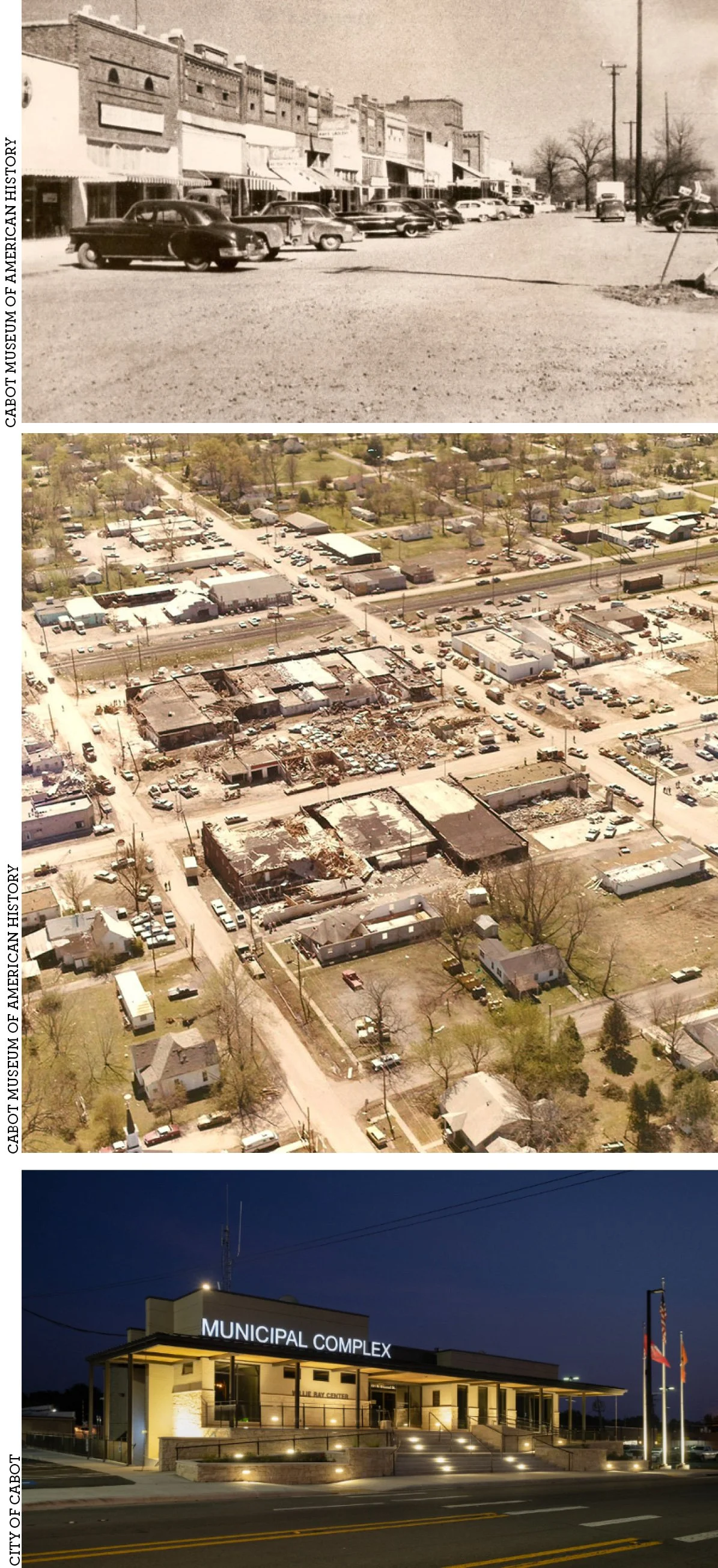Reimagining downtown as a space for art, entertainment and fellowship.
By James Walden and Alicia Payseno
The rendering depicts Railyard Park’s pavilion, a vibrant space for children and families to gather in downtown Cabot. - Photo from the City of Cabot
For many, vibrancy and Downtown Cabot are not two things ever considered linked. However, current city efforts are changing this reality and narrative, and improving the long-challenged downtown in dramatic ways.
Spend enough time in Cabot and you’ll eventually hear about March 29, 1976. It’s a date seared into the memories of longtime residents of a certain age and for good reason. That Monday afternoon a tornado struck the heart of the city, destroying much of downtown. In one fell swoop, much of the city’s history was destroyed, with 15 blocks decimated and over 90 buildings and homes damaged or destroyed. Second Street in downtown suffered some of the most significant damage. Most tragically, five people died as a result of the storm.
This event occurred at a uniquely pernicious time in history for downtowns. As suburbs like Cabot were blossoming, downtowns were facing a crisis. Suburbanization began removing the pillars of city centers — namely retail, restaurants and institutions — to the edges of cities where access and parking were convenient by car. Downtowns were left hollowed out with only their architectural character and the sentimentality of residents as driving forces to locate, stay or visit the heart of the community.
Cities across America attempted to make downtowns competitive by redesigning them to mimic their suburban shopping center competitors. Noble rebuilding efforts in Cabot followed this trend, as it was considered an absolute best practice at the time. The result was the transformation of a once-thriving First Street into a suburban strip mall.
Unfortunately, also following national trends, this effort didn’t save downtown. Until recently the area has coasted along, propelled by City Hall and the post office as key anchors. That changed in 2019.
A local grassroots coalition supported by city leadership partnered with the Clinton School and Alchemy Community Transformations to study downtown. Together they held community visioning sessions that focused on creative placemaking. Over the next six months they held meetings and conducted interviews with community leaders to identify needs. From these meetings it became apparent that Cabot lacked a place the community could gather for arts, entertainment and commerce. The study concluded that the downtown area would create a natural location for this revitalization effort.
From this plan the Cabot Foundation for Arts & Culture non-profit was formed to lead public art efforts downtown. Working alongside the city, this organization was instrumental in the coordination, placement, funding and design of several public art murals. Downtown Cabot now boasts six large-scale murals as well as the Cabot Art Walk with 23 mini murals. In addition, downtown is host to the Cabot Firehouse Film Festival each fall. These efforts have added to the area’s visual interest and created new programming to bring visitors downtown. However, the work has extended beyond art.
From top to bottom: Cabot’s bustling, 1940s-era downtown starkly contrasts with the damage from the tornado on March 29, 1976. The municipal complex, which houses the city hall and plaza, breathes energy into Cabot’s modern-day downtown.
The planning endeavor identified that public spaces downtown were outdated and underutilized. Realizing this, city officials pushed to pursue funding to improve City Hall and its adjacent plaza. In 2021, Cabot residents went to the polls and overwhelmingly passed an extension of a city sales tax and the issuance of $72 million in bonds for community and economic development. Among the projects included and approved at the ballot were long-needed renovations to City Hall, a reimagining of City Hall plaza into Rail Yard Park, and the Rail Yard Pavilion.
Sitting between City Hall and First Street in the heart of downtown, Rail Yard Park is now a place where children regardless of ability have a safe and fun place to play and interact with other kids. It also importantly helps activate downtown during off-peak times, such as early evenings and weekends. Rail Yard Pavilion adds another dimension to the downtown experience. It serves as a home for festivals downtown, provides space for the community’s farmers market, and provides a place for live music and entertainment. It too helps bring visitors downtown during off-peak times and provides a ripe opportunity for programming that will make downtown a destination.
These public investments are having a catalytic effect. New businesses are popping up downtown. Metropolitan Emergency Medical Services, or MEMS, a new partner with the city, has located a facility in a former post office building. The former Central Fire Station that had housed the Cabot Fire Department now houses the Cabot Firehouse Film Festival, and discussions are ongoing with investors on potential adaptive reuse concepts for the structure, potentially even including a future brewpub.
Downtown Cabot’s future is bright, and the city’s path of public investment primes the pump for additional private investment. This ultimately creates a virtuous cycle of improvement and increased vitality for downtown. It’s an effort that honors the foundations laid by past generations and looks forward to creating a vibrant space for future generations to enjoy and make their own.
James Walden is an urban planning leader with Garver.
Alicia Payseno is the director of economic development for the city of Cabot.




